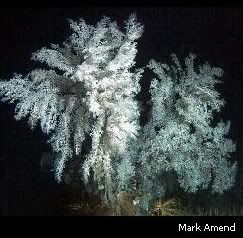
E: Environment, Enrichment,
Education, & Endangered Species
All content © by Diana L. Guerrero unless otherwise noted and may not be reprinted without prior written permission. All rights reserved. Click here for reprint permissions and fees.
Christmas Tree Black Coral (Antipathes dendrochristos) is a recently discovered coral and our animal of the month. This animal was confirmed as a new species in 2005. Research behind the Channel Islands Christmas Tree Black Coral (Antipathes dendrochristos) discovery was supported by: the David and Lucile Packard Foundation; NOAA Fisheries SWFSC, Offices of Habitat Conservation and Protected Resources, National Undersea Program, and Marine Protected Area Science Institute; California Artificial Reef Enhancement Program; the National Museum of Natural History of the Smithsonian Institution; and the Oak Ridge National Laboratory.
Animal of the Month
Christmas Tree Black Coral
(Antipathes dendrochristos)
A new species of black coral was discovered off southern California near the Channel Islands. The discovery by Milton Love a marine biologist at the University of California at Santa Barbara and Mary Yoklavich of the National Oceanic and Atmospheric Administration (NOAA) Fisheries was reported in the online journal, ZooTaxa. The healthy colonies of the coral were first noticed during surveys in a submersible in 2002.
The new species of black coral is found at depths of between 300 to 725 feet. Those who discover new species have the opportunity to name them. Mitlton Love chose to name the new species "Christmas Tree Coral" (Antipathes dendochristos) since it grows higher than two meters and resembles pink, white and red flocked Christmas trees.
The word origin for black coral is "Anti" for against, and "pathos" for disease, a reference to the fact that black coral amulets were once thought to provide protection against disease and evil spirits.
The Christmas tree coral was first noticed by the researchers during dives for surveys of rockfishes on deep rocky banks about 40 miles off the coast, west of Los Angeles in the submersible, Delta.
Many of the deepwater reefs in southern California serve as homes to remarkably healthy communities of corals, sponges, and other large invertebrates.
The corals are home to thriving undersea communities. Love said, "Historically, there has been relatively little trawling over reefs in our area. What we need to know is the role that these large invertebrates play as deep-water habitats for fishes and other marine life."
Love commented that scientists have also found a new species of worm there, "a new animal living on the new animal."
"What is really remarkable," said biologist Mary Yoklavich from NOAA Fisheries, "is that these spectacular large colonies have managed to go unnoticed while living in the backyard of the largest urban area on the West Coast."
The life form is a type of black coral (the color it turns when it dies). Samples were sent to expert Dennis Opresko at the Oak Ridge National Laboratory in Tennessee and reported in the online journal ZooTaxa in February 2005..
In fact, there may be two new species, although DNA testing will be needed to confirm that.
There are about 230 species of black coral around the world, from the tropics to Antarctica. Six or seven new ones may be formally named this year alone. Most are in deep water and some types are prized for jewelry.
The use of submersibles and remote cameras has opened up the deep seas and allowed more discoveries. Scientific discovery is one of the most exciting parts of science.





